Detailed Process Design of a Nuclear Power Station - ENS 2116 Report
VerifiedAdded on 2022/10/06
|28
|5727
|496
Report
AI Summary
This report provides a comprehensive analysis of the process design within a nuclear power station, detailing the entire operational cycle from the initial loading of uranium fuel to the generation of electricity. It explores the core components, including the reactor core, control rods, and coolant systems, and explains the process of nuclear fission and the subsequent conversion of heat into steam to drive turbines. The report differentiates between pressurized water reactors (PWRs) and boiling water reactors (BWRs), outlining their respective designs and operational characteristics. It also presents block flow diagrams and process flow diagrams (PFDs) to visually represent the process, along with a discussion of design criteria and safety measures essential for the safe and efficient operation of a nuclear power plant. The report emphasizes the importance of the defense-in-depth strategy in ensuring the safety of workers, the surrounding environment, and the public, along with the overall design objectives of the nuclear power plant.
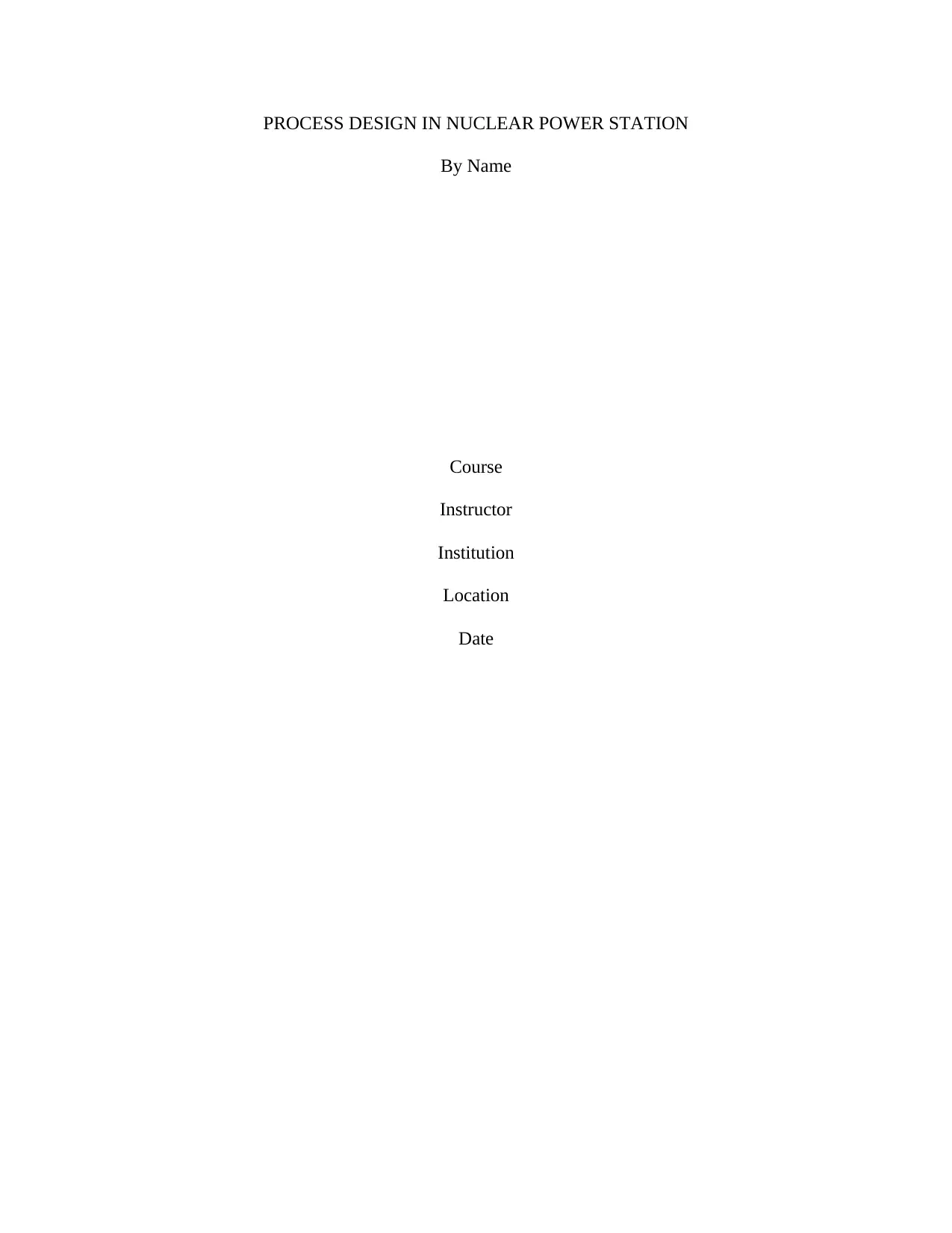
PROCESS DESIGN IN NUCLEAR POWER STATION
By Name
Course
Instructor
Institution
Location
Date
By Name
Course
Instructor
Institution
Location
Date
Paraphrase This Document
Need a fresh take? Get an instant paraphrase of this document with our AI Paraphraser
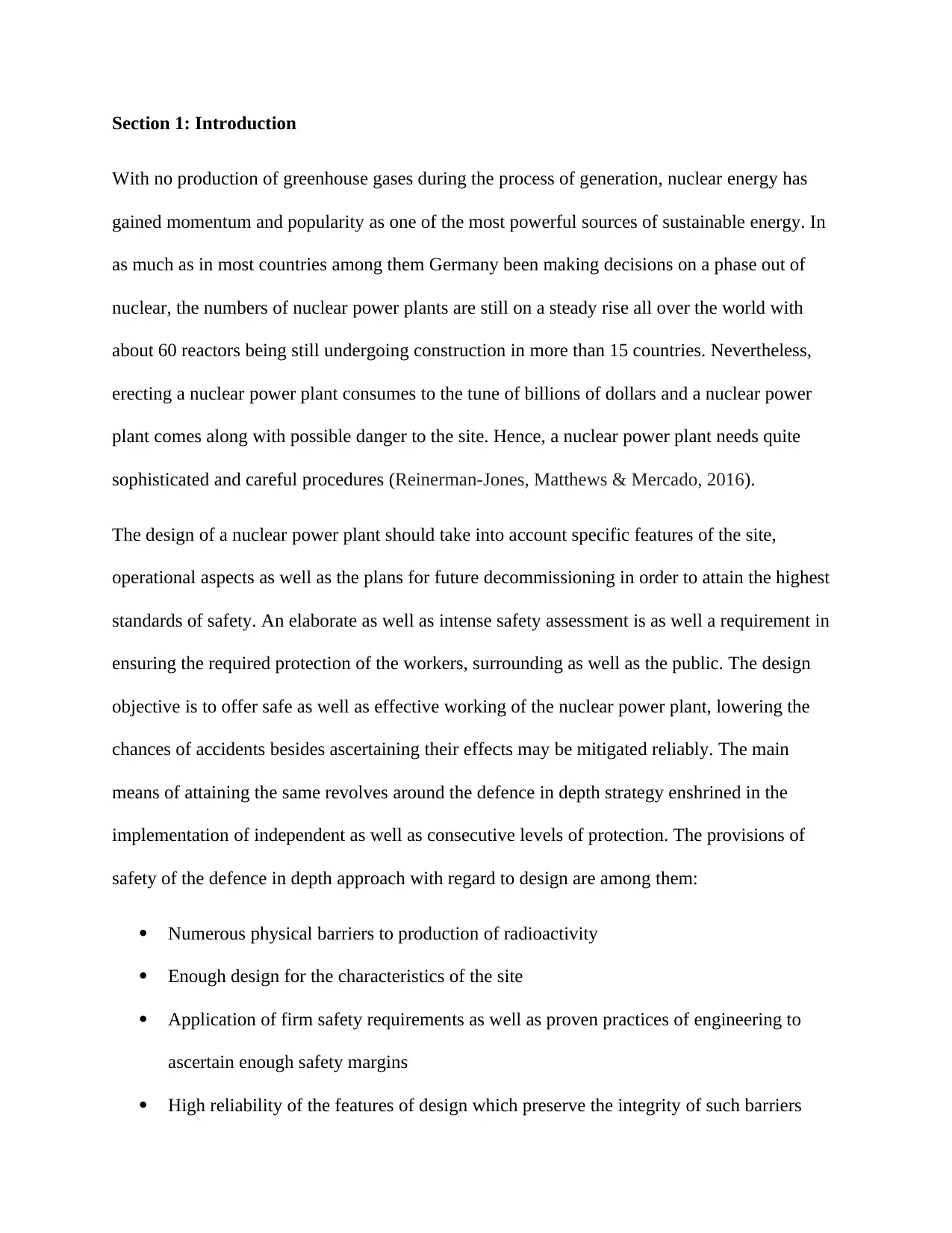
Section 1: Introduction
With no production of greenhouse gases during the process of generation, nuclear energy has
gained momentum and popularity as one of the most powerful sources of sustainable energy. In
as much as in most countries among them Germany been making decisions on a phase out of
nuclear, the numbers of nuclear power plants are still on a steady rise all over the world with
about 60 reactors being still undergoing construction in more than 15 countries. Nevertheless,
erecting a nuclear power plant consumes to the tune of billions of dollars and a nuclear power
plant comes along with possible danger to the site. Hence, a nuclear power plant needs quite
sophisticated and careful procedures (Reinerman-Jones, Matthews & Mercado, 2016).
The design of a nuclear power plant should take into account specific features of the site,
operational aspects as well as the plans for future decommissioning in order to attain the highest
standards of safety. An elaborate as well as intense safety assessment is as well a requirement in
ensuring the required protection of the workers, surrounding as well as the public. The design
objective is to offer safe as well as effective working of the nuclear power plant, lowering the
chances of accidents besides ascertaining their effects may be mitigated reliably. The main
means of attaining the same revolves around the defence in depth strategy enshrined in the
implementation of independent as well as consecutive levels of protection. The provisions of
safety of the defence in depth approach with regard to design are among them:
Numerous physical barriers to production of radioactivity
Enough design for the characteristics of the site
Application of firm safety requirements as well as proven practices of engineering to
ascertain enough safety margins
High reliability of the features of design which preserve the integrity of such barriers
With no production of greenhouse gases during the process of generation, nuclear energy has
gained momentum and popularity as one of the most powerful sources of sustainable energy. In
as much as in most countries among them Germany been making decisions on a phase out of
nuclear, the numbers of nuclear power plants are still on a steady rise all over the world with
about 60 reactors being still undergoing construction in more than 15 countries. Nevertheless,
erecting a nuclear power plant consumes to the tune of billions of dollars and a nuclear power
plant comes along with possible danger to the site. Hence, a nuclear power plant needs quite
sophisticated and careful procedures (Reinerman-Jones, Matthews & Mercado, 2016).
The design of a nuclear power plant should take into account specific features of the site,
operational aspects as well as the plans for future decommissioning in order to attain the highest
standards of safety. An elaborate as well as intense safety assessment is as well a requirement in
ensuring the required protection of the workers, surrounding as well as the public. The design
objective is to offer safe as well as effective working of the nuclear power plant, lowering the
chances of accidents besides ascertaining their effects may be mitigated reliably. The main
means of attaining the same revolves around the defence in depth strategy enshrined in the
implementation of independent as well as consecutive levels of protection. The provisions of
safety of the defence in depth approach with regard to design are among them:
Numerous physical barriers to production of radioactivity
Enough design for the characteristics of the site
Application of firm safety requirements as well as proven practices of engineering to
ascertain enough safety margins
High reliability of the features of design which preserve the integrity of such barriers
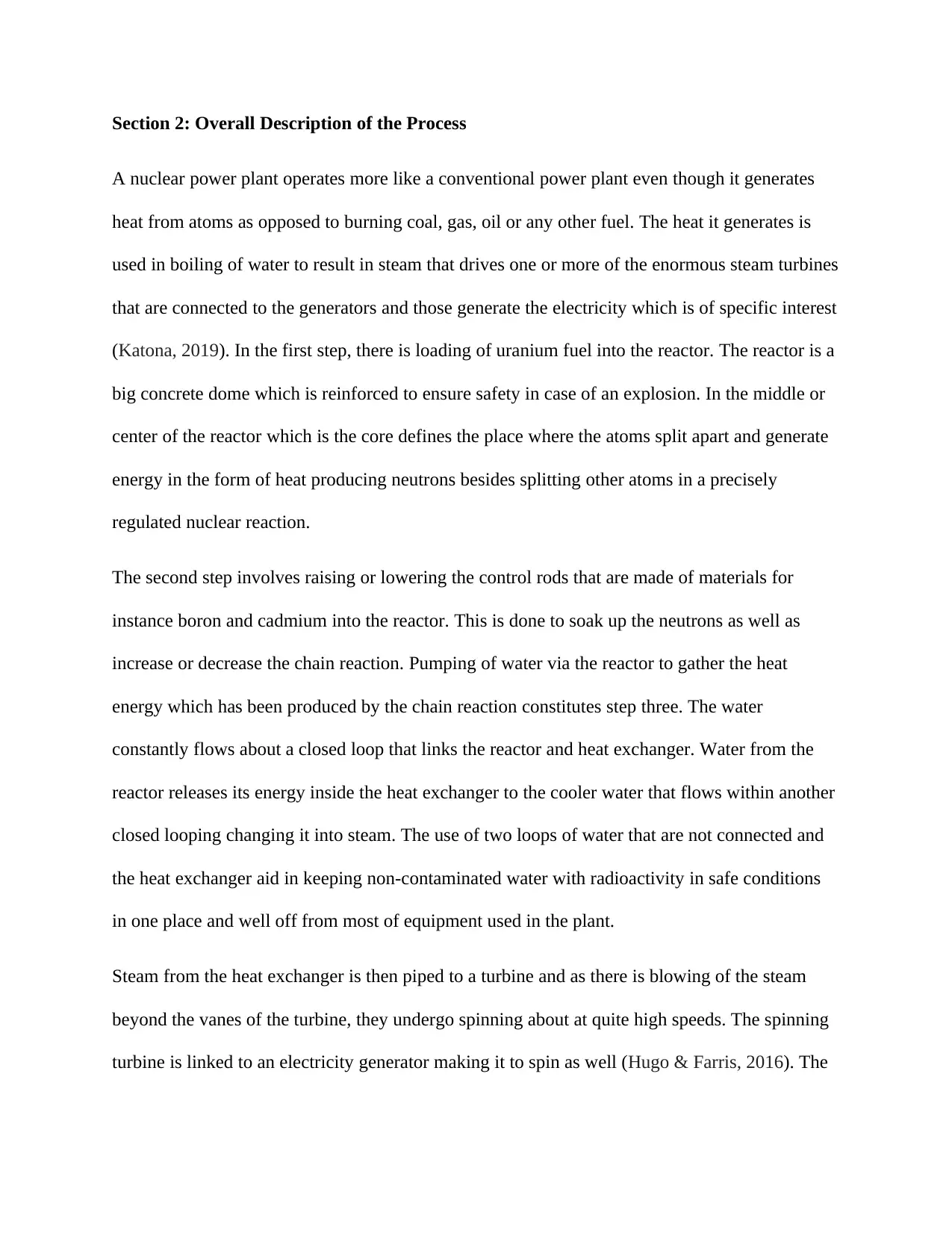
Section 2: Overall Description of the Process
A nuclear power plant operates more like a conventional power plant even though it generates
heat from atoms as opposed to burning coal, gas, oil or any other fuel. The heat it generates is
used in boiling of water to result in steam that drives one or more of the enormous steam turbines
that are connected to the generators and those generate the electricity which is of specific interest
(Katona, 2019). In the first step, there is loading of uranium fuel into the reactor. The reactor is a
big concrete dome which is reinforced to ensure safety in case of an explosion. In the middle or
center of the reactor which is the core defines the place where the atoms split apart and generate
energy in the form of heat producing neutrons besides splitting other atoms in a precisely
regulated nuclear reaction.
The second step involves raising or lowering the control rods that are made of materials for
instance boron and cadmium into the reactor. This is done to soak up the neutrons as well as
increase or decrease the chain reaction. Pumping of water via the reactor to gather the heat
energy which has been produced by the chain reaction constitutes step three. The water
constantly flows about a closed loop that links the reactor and heat exchanger. Water from the
reactor releases its energy inside the heat exchanger to the cooler water that flows within another
closed looping changing it into steam. The use of two loops of water that are not connected and
the heat exchanger aid in keeping non-contaminated water with radioactivity in safe conditions
in one place and well off from most of equipment used in the plant.
Steam from the heat exchanger is then piped to a turbine and as there is blowing of the steam
beyond the vanes of the turbine, they undergo spinning about at quite high speeds. The spinning
turbine is linked to an electricity generator making it to spin as well (Hugo & Farris, 2016). The
A nuclear power plant operates more like a conventional power plant even though it generates
heat from atoms as opposed to burning coal, gas, oil or any other fuel. The heat it generates is
used in boiling of water to result in steam that drives one or more of the enormous steam turbines
that are connected to the generators and those generate the electricity which is of specific interest
(Katona, 2019). In the first step, there is loading of uranium fuel into the reactor. The reactor is a
big concrete dome which is reinforced to ensure safety in case of an explosion. In the middle or
center of the reactor which is the core defines the place where the atoms split apart and generate
energy in the form of heat producing neutrons besides splitting other atoms in a precisely
regulated nuclear reaction.
The second step involves raising or lowering the control rods that are made of materials for
instance boron and cadmium into the reactor. This is done to soak up the neutrons as well as
increase or decrease the chain reaction. Pumping of water via the reactor to gather the heat
energy which has been produced by the chain reaction constitutes step three. The water
constantly flows about a closed loop that links the reactor and heat exchanger. Water from the
reactor releases its energy inside the heat exchanger to the cooler water that flows within another
closed looping changing it into steam. The use of two loops of water that are not connected and
the heat exchanger aid in keeping non-contaminated water with radioactivity in safe conditions
in one place and well off from most of equipment used in the plant.
Steam from the heat exchanger is then piped to a turbine and as there is blowing of the steam
beyond the vanes of the turbine, they undergo spinning about at quite high speeds. The spinning
turbine is linked to an electricity generator making it to spin as well (Hugo & Farris, 2016). The
⊘ This is a preview!⊘
Do you want full access?
Subscribe today to unlock all pages.

Trusted by 1+ million students worldwide
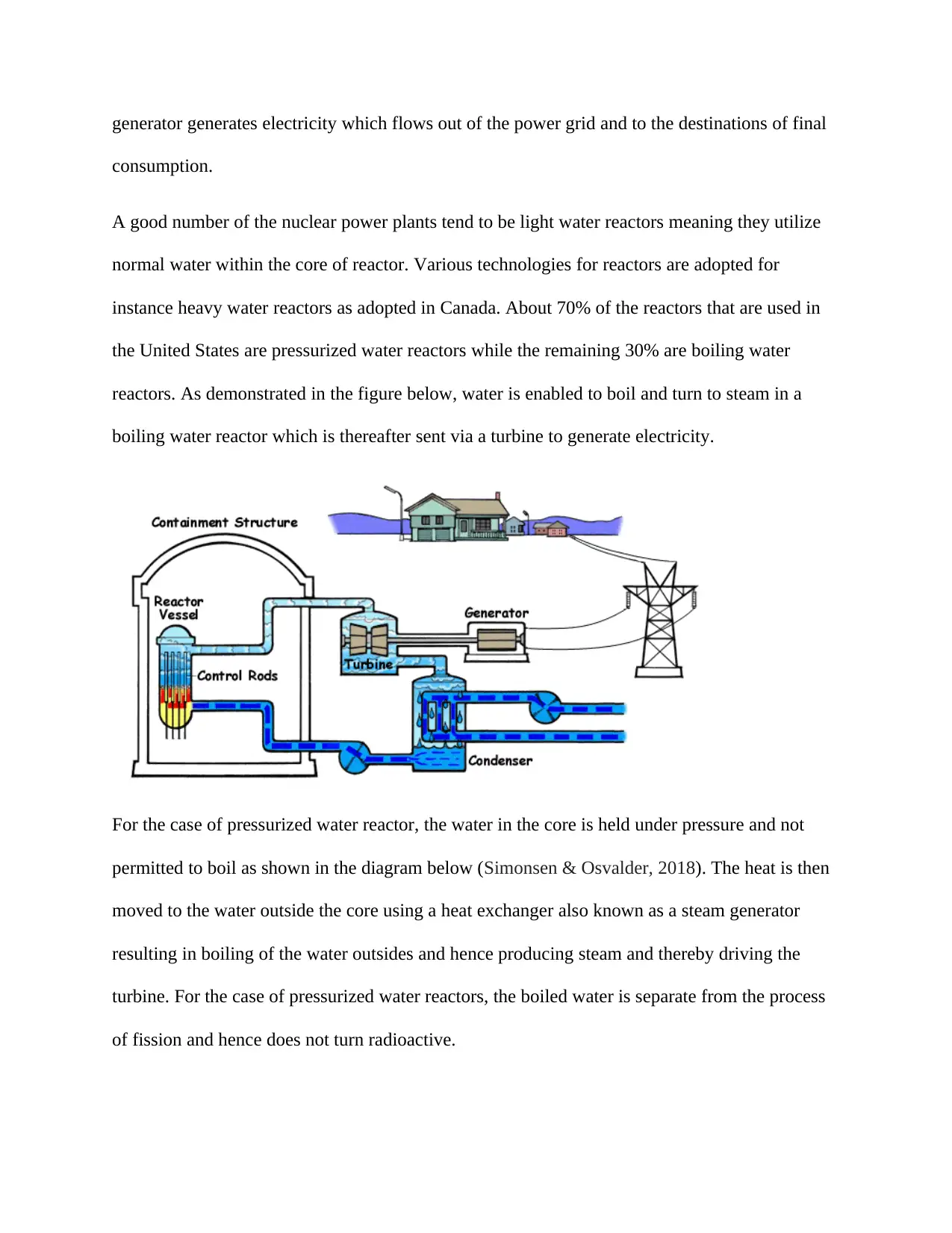
generator generates electricity which flows out of the power grid and to the destinations of final
consumption.
A good number of the nuclear power plants tend to be light water reactors meaning they utilize
normal water within the core of reactor. Various technologies for reactors are adopted for
instance heavy water reactors as adopted in Canada. About 70% of the reactors that are used in
the United States are pressurized water reactors while the remaining 30% are boiling water
reactors. As demonstrated in the figure below, water is enabled to boil and turn to steam in a
boiling water reactor which is thereafter sent via a turbine to generate electricity.
For the case of pressurized water reactor, the water in the core is held under pressure and not
permitted to boil as shown in the diagram below (Simonsen & Osvalder, 2018). The heat is then
moved to the water outside the core using a heat exchanger also known as a steam generator
resulting in boiling of the water outsides and hence producing steam and thereby driving the
turbine. For the case of pressurized water reactors, the boiled water is separate from the process
of fission and hence does not turn radioactive.
consumption.
A good number of the nuclear power plants tend to be light water reactors meaning they utilize
normal water within the core of reactor. Various technologies for reactors are adopted for
instance heavy water reactors as adopted in Canada. About 70% of the reactors that are used in
the United States are pressurized water reactors while the remaining 30% are boiling water
reactors. As demonstrated in the figure below, water is enabled to boil and turn to steam in a
boiling water reactor which is thereafter sent via a turbine to generate electricity.
For the case of pressurized water reactor, the water in the core is held under pressure and not
permitted to boil as shown in the diagram below (Simonsen & Osvalder, 2018). The heat is then
moved to the water outside the core using a heat exchanger also known as a steam generator
resulting in boiling of the water outsides and hence producing steam and thereby driving the
turbine. For the case of pressurized water reactors, the boiled water is separate from the process
of fission and hence does not turn radioactive.
Paraphrase This Document
Need a fresh take? Get an instant paraphrase of this document with our AI Paraphraser
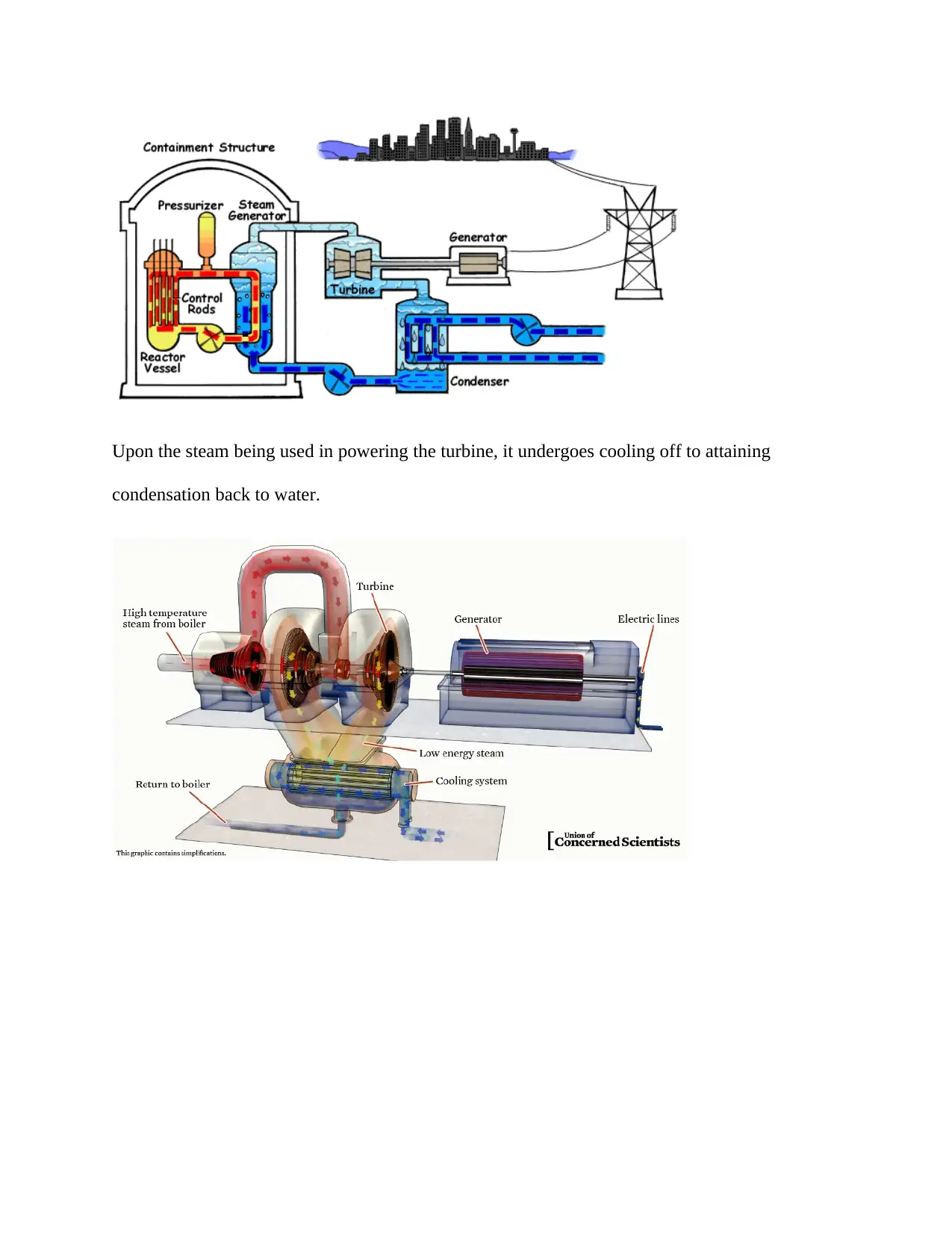
Upon the steam being used in powering the turbine, it undergoes cooling off to attaining
condensation back to water.
condensation back to water.
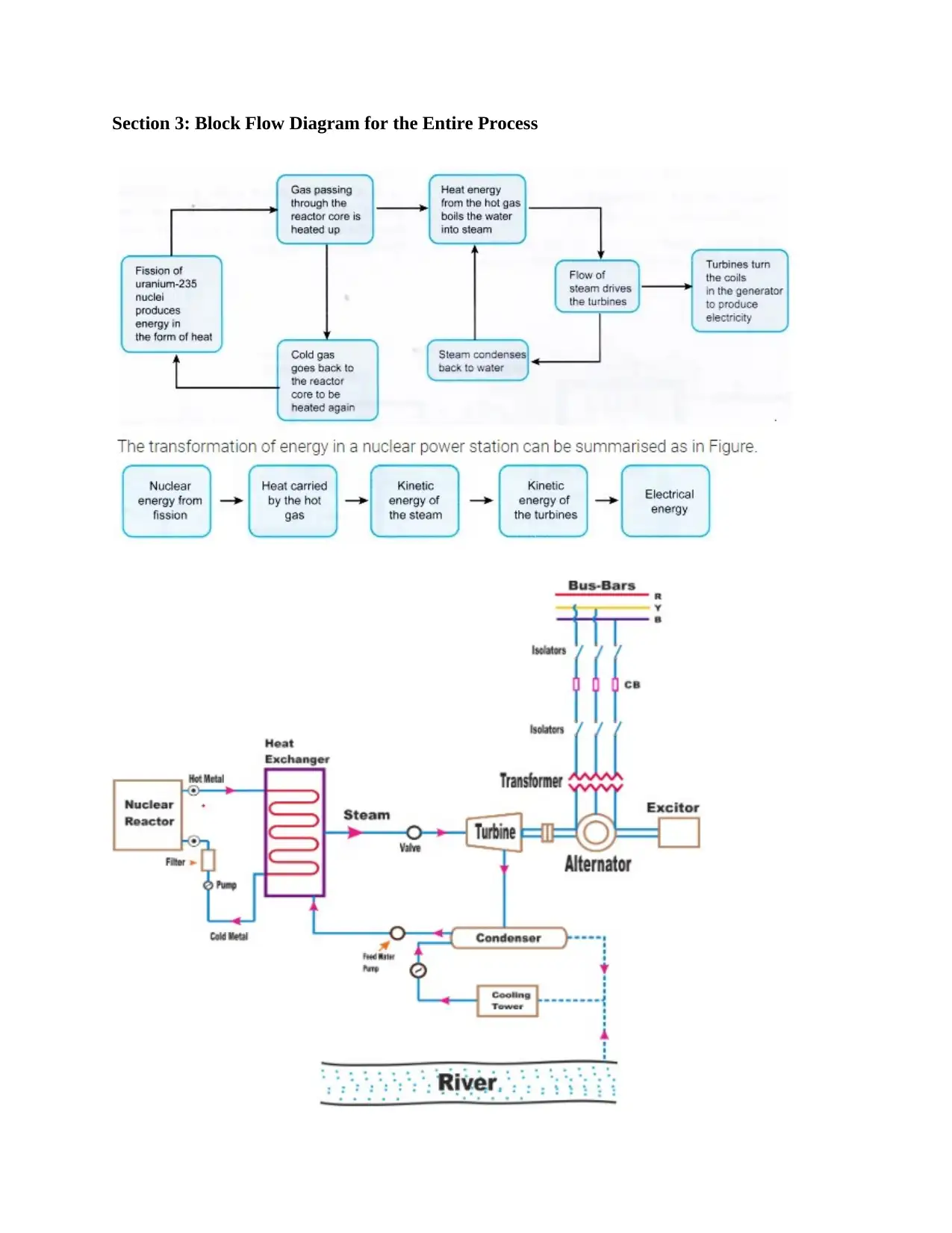
Section 3: Block Flow Diagram for the Entire Process
⊘ This is a preview!⊘
Do you want full access?
Subscribe today to unlock all pages.

Trusted by 1+ million students worldwide
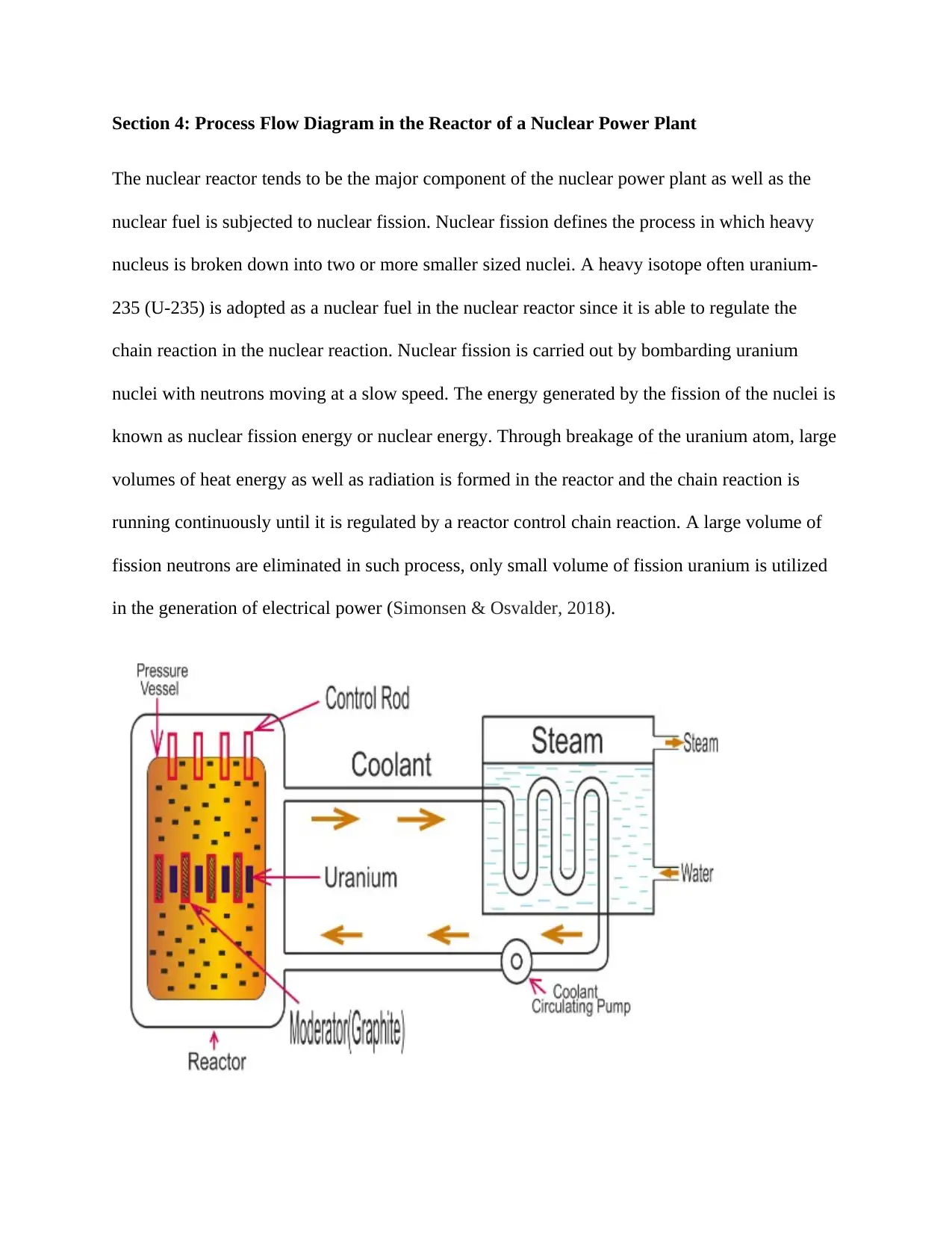
Section 4: Process Flow Diagram in the Reactor of a Nuclear Power Plant
The nuclear reactor tends to be the major component of the nuclear power plant as well as the
nuclear fuel is subjected to nuclear fission. Nuclear fission defines the process in which heavy
nucleus is broken down into two or more smaller sized nuclei. A heavy isotope often uranium-
235 (U-235) is adopted as a nuclear fuel in the nuclear reactor since it is able to regulate the
chain reaction in the nuclear reaction. Nuclear fission is carried out by bombarding uranium
nuclei with neutrons moving at a slow speed. The energy generated by the fission of the nuclei is
known as nuclear fission energy or nuclear energy. Through breakage of the uranium atom, large
volumes of heat energy as well as radiation is formed in the reactor and the chain reaction is
running continuously until it is regulated by a reactor control chain reaction. A large volume of
fission neutrons are eliminated in such process, only small volume of fission uranium is utilized
in the generation of electrical power (Simonsen & Osvalder, 2018).
The nuclear reactor tends to be the major component of the nuclear power plant as well as the
nuclear fuel is subjected to nuclear fission. Nuclear fission defines the process in which heavy
nucleus is broken down into two or more smaller sized nuclei. A heavy isotope often uranium-
235 (U-235) is adopted as a nuclear fuel in the nuclear reactor since it is able to regulate the
chain reaction in the nuclear reaction. Nuclear fission is carried out by bombarding uranium
nuclei with neutrons moving at a slow speed. The energy generated by the fission of the nuclei is
known as nuclear fission energy or nuclear energy. Through breakage of the uranium atom, large
volumes of heat energy as well as radiation is formed in the reactor and the chain reaction is
running continuously until it is regulated by a reactor control chain reaction. A large volume of
fission neutrons are eliminated in such process, only small volume of fission uranium is utilized
in the generation of electrical power (Simonsen & Osvalder, 2018).
Paraphrase This Document
Need a fresh take? Get an instant paraphrase of this document with our AI Paraphraser
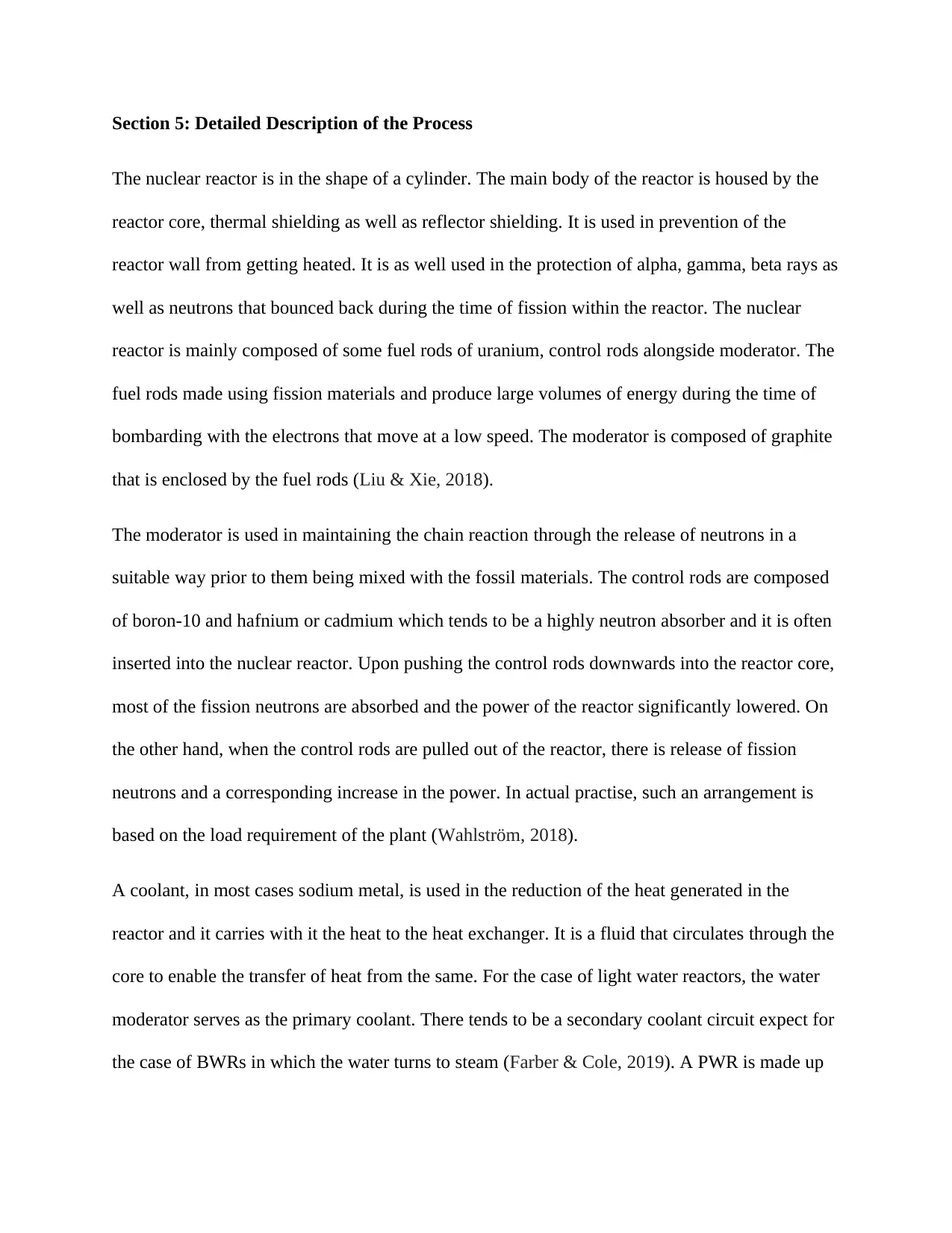
Section 5: Detailed Description of the Process
The nuclear reactor is in the shape of a cylinder. The main body of the reactor is housed by the
reactor core, thermal shielding as well as reflector shielding. It is used in prevention of the
reactor wall from getting heated. It is as well used in the protection of alpha, gamma, beta rays as
well as neutrons that bounced back during the time of fission within the reactor. The nuclear
reactor is mainly composed of some fuel rods of uranium, control rods alongside moderator. The
fuel rods made using fission materials and produce large volumes of energy during the time of
bombarding with the electrons that move at a low speed. The moderator is composed of graphite
that is enclosed by the fuel rods (Liu & Xie, 2018).
The moderator is used in maintaining the chain reaction through the release of neutrons in a
suitable way prior to them being mixed with the fossil materials. The control rods are composed
of boron-10 and hafnium or cadmium which tends to be a highly neutron absorber and it is often
inserted into the nuclear reactor. Upon pushing the control rods downwards into the reactor core,
most of the fission neutrons are absorbed and the power of the reactor significantly lowered. On
the other hand, when the control rods are pulled out of the reactor, there is release of fission
neutrons and a corresponding increase in the power. In actual practise, such an arrangement is
based on the load requirement of the plant (Wahlström, 2018).
A coolant, in most cases sodium metal, is used in the reduction of the heat generated in the
reactor and it carries with it the heat to the heat exchanger. It is a fluid that circulates through the
core to enable the transfer of heat from the same. For the case of light water reactors, the water
moderator serves as the primary coolant. There tends to be a secondary coolant circuit expect for
the case of BWRs in which the water turns to steam (Farber & Cole, 2019). A PWR is made up
The nuclear reactor is in the shape of a cylinder. The main body of the reactor is housed by the
reactor core, thermal shielding as well as reflector shielding. It is used in prevention of the
reactor wall from getting heated. It is as well used in the protection of alpha, gamma, beta rays as
well as neutrons that bounced back during the time of fission within the reactor. The nuclear
reactor is mainly composed of some fuel rods of uranium, control rods alongside moderator. The
fuel rods made using fission materials and produce large volumes of energy during the time of
bombarding with the electrons that move at a low speed. The moderator is composed of graphite
that is enclosed by the fuel rods (Liu & Xie, 2018).
The moderator is used in maintaining the chain reaction through the release of neutrons in a
suitable way prior to them being mixed with the fossil materials. The control rods are composed
of boron-10 and hafnium or cadmium which tends to be a highly neutron absorber and it is often
inserted into the nuclear reactor. Upon pushing the control rods downwards into the reactor core,
most of the fission neutrons are absorbed and the power of the reactor significantly lowered. On
the other hand, when the control rods are pulled out of the reactor, there is release of fission
neutrons and a corresponding increase in the power. In actual practise, such an arrangement is
based on the load requirement of the plant (Wahlström, 2018).
A coolant, in most cases sodium metal, is used in the reduction of the heat generated in the
reactor and it carries with it the heat to the heat exchanger. It is a fluid that circulates through the
core to enable the transfer of heat from the same. For the case of light water reactors, the water
moderator serves as the primary coolant. There tends to be a secondary coolant circuit expect for
the case of BWRs in which the water turns to steam (Farber & Cole, 2019). A PWR is made up
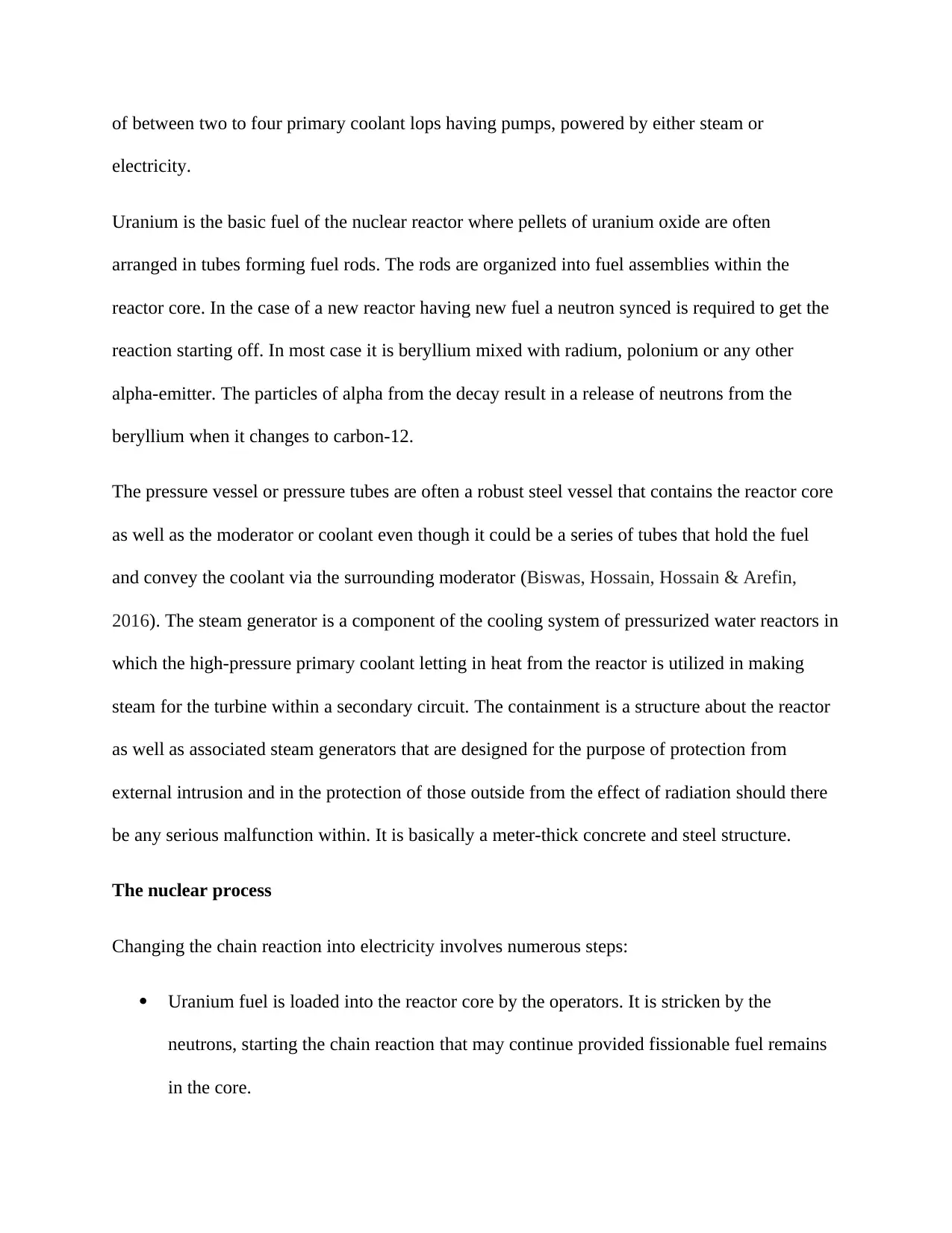
of between two to four primary coolant lops having pumps, powered by either steam or
electricity.
Uranium is the basic fuel of the nuclear reactor where pellets of uranium oxide are often
arranged in tubes forming fuel rods. The rods are organized into fuel assemblies within the
reactor core. In the case of a new reactor having new fuel a neutron synced is required to get the
reaction starting off. In most case it is beryllium mixed with radium, polonium or any other
alpha-emitter. The particles of alpha from the decay result in a release of neutrons from the
beryllium when it changes to carbon-12.
The pressure vessel or pressure tubes are often a robust steel vessel that contains the reactor core
as well as the moderator or coolant even though it could be a series of tubes that hold the fuel
and convey the coolant via the surrounding moderator (Biswas, Hossain, Hossain & Arefin,
2016). The steam generator is a component of the cooling system of pressurized water reactors in
which the high-pressure primary coolant letting in heat from the reactor is utilized in making
steam for the turbine within a secondary circuit. The containment is a structure about the reactor
as well as associated steam generators that are designed for the purpose of protection from
external intrusion and in the protection of those outside from the effect of radiation should there
be any serious malfunction within. It is basically a meter-thick concrete and steel structure.
The nuclear process
Changing the chain reaction into electricity involves numerous steps:
Uranium fuel is loaded into the reactor core by the operators. It is stricken by the
neutrons, starting the chain reaction that may continue provided fissionable fuel remains
in the core.
electricity.
Uranium is the basic fuel of the nuclear reactor where pellets of uranium oxide are often
arranged in tubes forming fuel rods. The rods are organized into fuel assemblies within the
reactor core. In the case of a new reactor having new fuel a neutron synced is required to get the
reaction starting off. In most case it is beryllium mixed with radium, polonium or any other
alpha-emitter. The particles of alpha from the decay result in a release of neutrons from the
beryllium when it changes to carbon-12.
The pressure vessel or pressure tubes are often a robust steel vessel that contains the reactor core
as well as the moderator or coolant even though it could be a series of tubes that hold the fuel
and convey the coolant via the surrounding moderator (Biswas, Hossain, Hossain & Arefin,
2016). The steam generator is a component of the cooling system of pressurized water reactors in
which the high-pressure primary coolant letting in heat from the reactor is utilized in making
steam for the turbine within a secondary circuit. The containment is a structure about the reactor
as well as associated steam generators that are designed for the purpose of protection from
external intrusion and in the protection of those outside from the effect of radiation should there
be any serious malfunction within. It is basically a meter-thick concrete and steel structure.
The nuclear process
Changing the chain reaction into electricity involves numerous steps:
Uranium fuel is loaded into the reactor core by the operators. It is stricken by the
neutrons, starting the chain reaction that may continue provided fissionable fuel remains
in the core.
⊘ This is a preview!⊘
Do you want full access?
Subscribe today to unlock all pages.

Trusted by 1+ million students worldwide
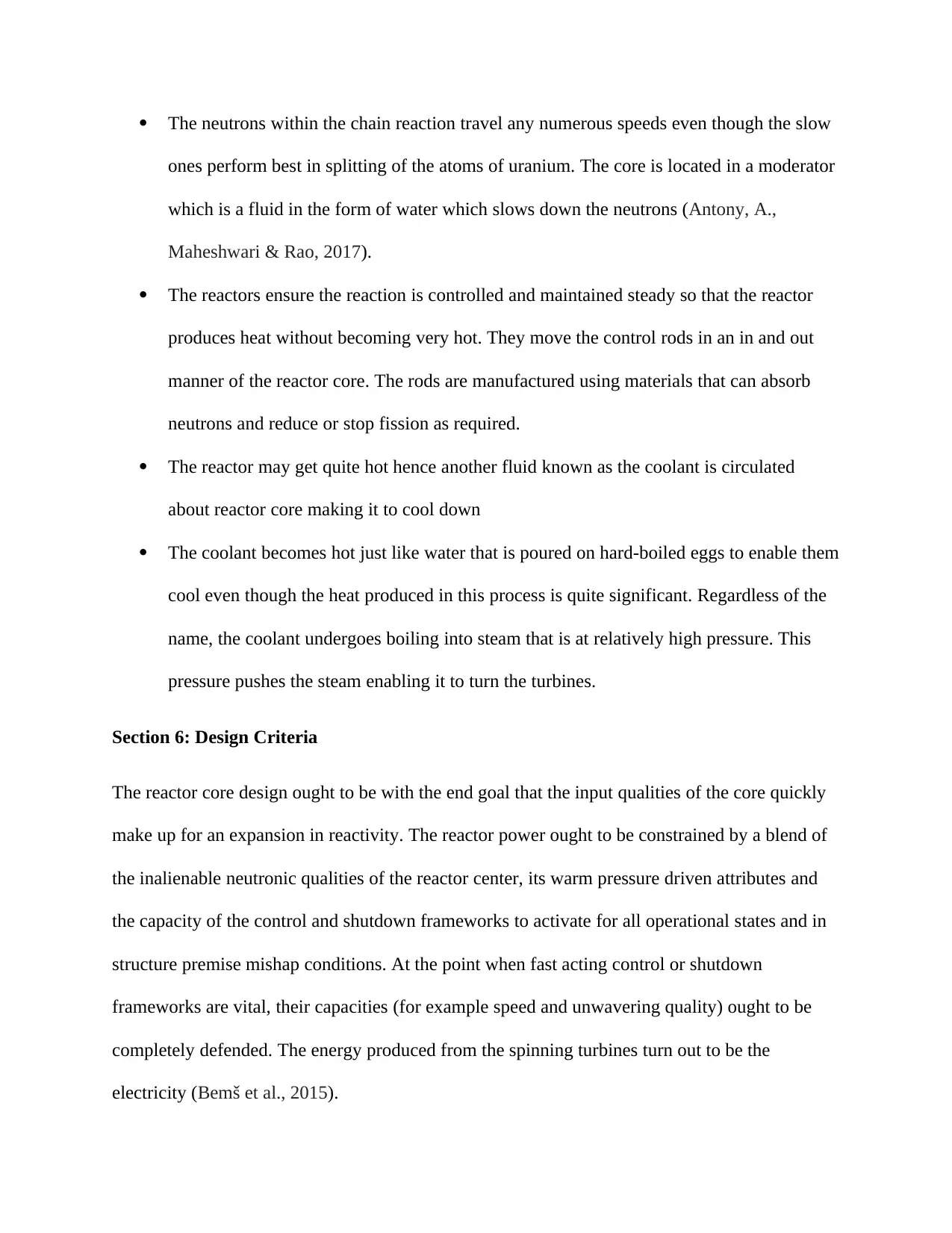
The neutrons within the chain reaction travel any numerous speeds even though the slow
ones perform best in splitting of the atoms of uranium. The core is located in a moderator
which is a fluid in the form of water which slows down the neutrons (Antony, A.,
Maheshwari & Rao, 2017).
The reactors ensure the reaction is controlled and maintained steady so that the reactor
produces heat without becoming very hot. They move the control rods in an in and out
manner of the reactor core. The rods are manufactured using materials that can absorb
neutrons and reduce or stop fission as required.
The reactor may get quite hot hence another fluid known as the coolant is circulated
about reactor core making it to cool down
The coolant becomes hot just like water that is poured on hard-boiled eggs to enable them
cool even though the heat produced in this process is quite significant. Regardless of the
name, the coolant undergoes boiling into steam that is at relatively high pressure. This
pressure pushes the steam enabling it to turn the turbines.
Section 6: Design Criteria
The reactor core design ought to be with the end goal that the input qualities of the core quickly
make up for an expansion in reactivity. The reactor power ought to be constrained by a blend of
the inalienable neutronic qualities of the reactor center, its warm pressure driven attributes and
the capacity of the control and shutdown frameworks to activate for all operational states and in
structure premise mishap conditions. At the point when fast acting control or shutdown
frameworks are vital, their capacities (for example speed and unwavering quality) ought to be
completely defended. The energy produced from the spinning turbines turn out to be the
electricity (Bemš et al., 2015).
ones perform best in splitting of the atoms of uranium. The core is located in a moderator
which is a fluid in the form of water which slows down the neutrons (Antony, A.,
Maheshwari & Rao, 2017).
The reactors ensure the reaction is controlled and maintained steady so that the reactor
produces heat without becoming very hot. They move the control rods in an in and out
manner of the reactor core. The rods are manufactured using materials that can absorb
neutrons and reduce or stop fission as required.
The reactor may get quite hot hence another fluid known as the coolant is circulated
about reactor core making it to cool down
The coolant becomes hot just like water that is poured on hard-boiled eggs to enable them
cool even though the heat produced in this process is quite significant. Regardless of the
name, the coolant undergoes boiling into steam that is at relatively high pressure. This
pressure pushes the steam enabling it to turn the turbines.
Section 6: Design Criteria
The reactor core design ought to be with the end goal that the input qualities of the core quickly
make up for an expansion in reactivity. The reactor power ought to be constrained by a blend of
the inalienable neutronic qualities of the reactor center, its warm pressure driven attributes and
the capacity of the control and shutdown frameworks to activate for all operational states and in
structure premise mishap conditions. At the point when fast acting control or shutdown
frameworks are vital, their capacities (for example speed and unwavering quality) ought to be
completely defended. The energy produced from the spinning turbines turn out to be the
electricity (Bemš et al., 2015).
Paraphrase This Document
Need a fresh take? Get an instant paraphrase of this document with our AI Paraphraser
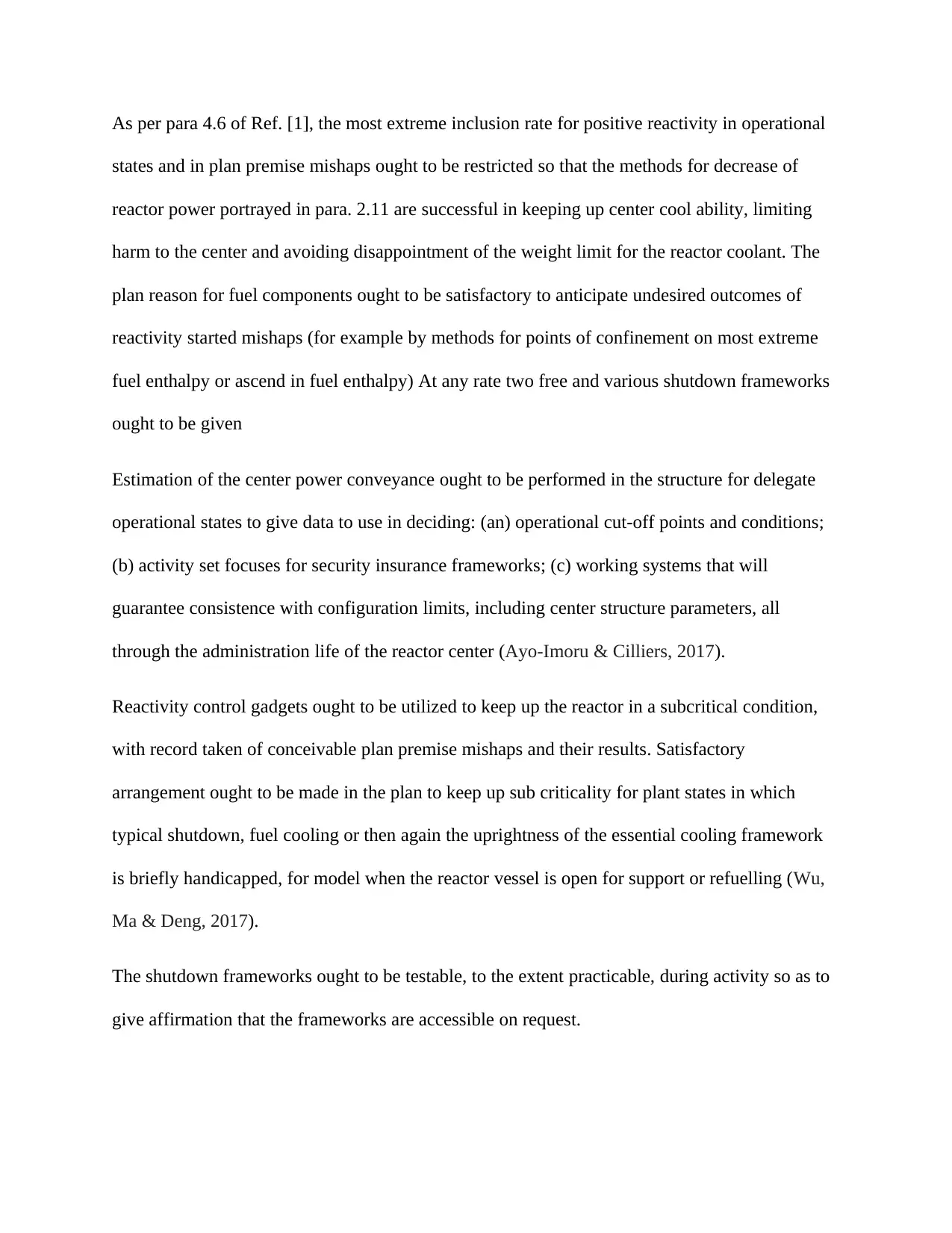
As per para 4.6 of Ref. [1], the most extreme inclusion rate for positive reactivity in operational
states and in plan premise mishaps ought to be restricted so that the methods for decrease of
reactor power portrayed in para. 2.11 are successful in keeping up center cool ability, limiting
harm to the center and avoiding disappointment of the weight limit for the reactor coolant. The
plan reason for fuel components ought to be satisfactory to anticipate undesired outcomes of
reactivity started mishaps (for example by methods for points of confinement on most extreme
fuel enthalpy or ascend in fuel enthalpy) At any rate two free and various shutdown frameworks
ought to be given
Estimation of the center power conveyance ought to be performed in the structure for delegate
operational states to give data to use in deciding: (an) operational cut-off points and conditions;
(b) activity set focuses for security insurance frameworks; (c) working systems that will
guarantee consistence with configuration limits, including center structure parameters, all
through the administration life of the reactor center (Ayo-Imoru & Cilliers, 2017).
Reactivity control gadgets ought to be utilized to keep up the reactor in a subcritical condition,
with record taken of conceivable plan premise mishaps and their results. Satisfactory
arrangement ought to be made in the plan to keep up sub criticality for plant states in which
typical shutdown, fuel cooling or then again the uprightness of the essential cooling framework
is briefly handicapped, for model when the reactor vessel is open for support or refuelling (Wu,
Ma & Deng, 2017).
The shutdown frameworks ought to be testable, to the extent practicable, during activity so as to
give affirmation that the frameworks are accessible on request.
states and in plan premise mishaps ought to be restricted so that the methods for decrease of
reactor power portrayed in para. 2.11 are successful in keeping up center cool ability, limiting
harm to the center and avoiding disappointment of the weight limit for the reactor coolant. The
plan reason for fuel components ought to be satisfactory to anticipate undesired outcomes of
reactivity started mishaps (for example by methods for points of confinement on most extreme
fuel enthalpy or ascend in fuel enthalpy) At any rate two free and various shutdown frameworks
ought to be given
Estimation of the center power conveyance ought to be performed in the structure for delegate
operational states to give data to use in deciding: (an) operational cut-off points and conditions;
(b) activity set focuses for security insurance frameworks; (c) working systems that will
guarantee consistence with configuration limits, including center structure parameters, all
through the administration life of the reactor center (Ayo-Imoru & Cilliers, 2017).
Reactivity control gadgets ought to be utilized to keep up the reactor in a subcritical condition,
with record taken of conceivable plan premise mishaps and their results. Satisfactory
arrangement ought to be made in the plan to keep up sub criticality for plant states in which
typical shutdown, fuel cooling or then again the uprightness of the essential cooling framework
is briefly handicapped, for model when the reactor vessel is open for support or refuelling (Wu,
Ma & Deng, 2017).
The shutdown frameworks ought to be testable, to the extent practicable, during activity so as to
give affirmation that the frameworks are accessible on request.
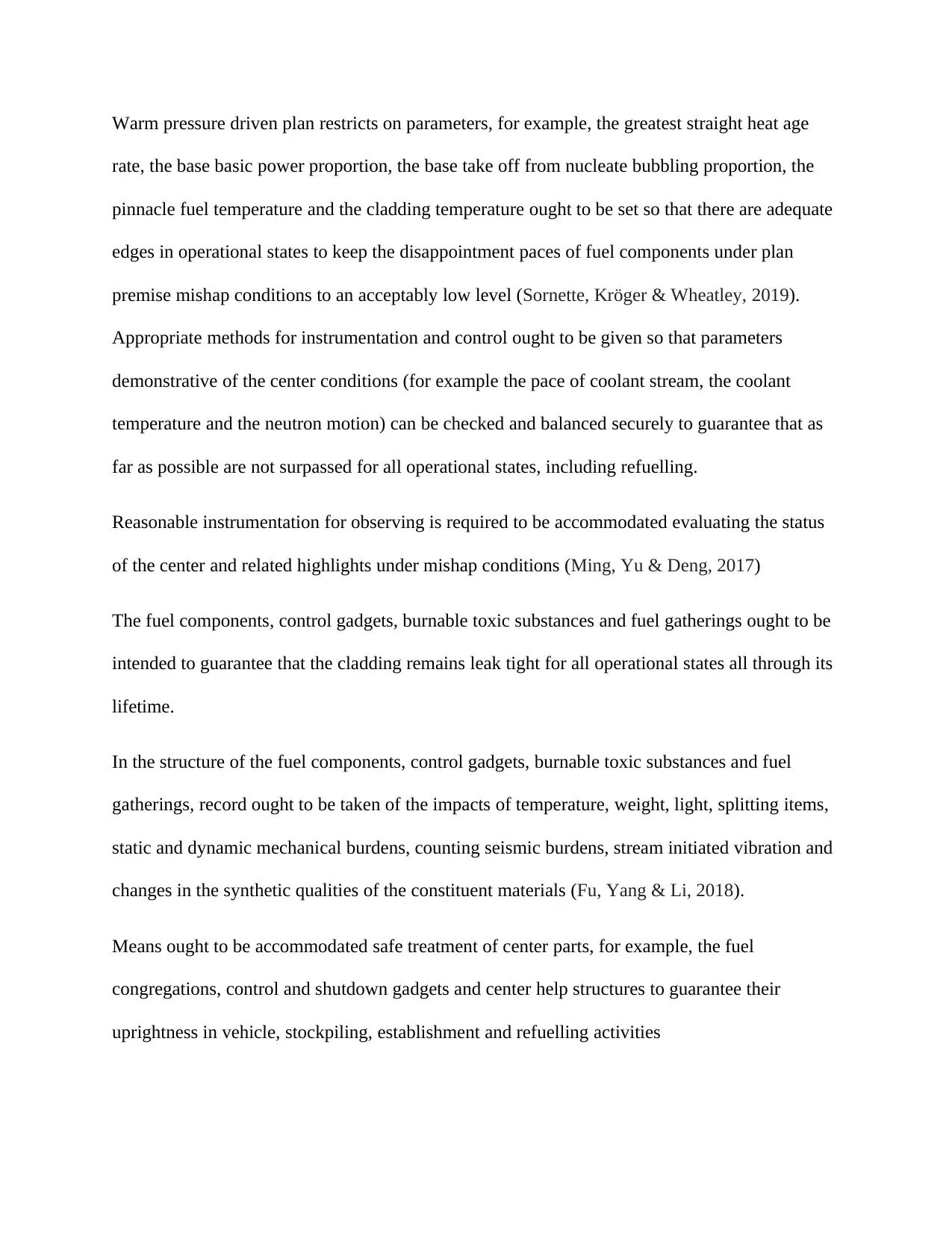
Warm pressure driven plan restricts on parameters, for example, the greatest straight heat age
rate, the base basic power proportion, the base take off from nucleate bubbling proportion, the
pinnacle fuel temperature and the cladding temperature ought to be set so that there are adequate
edges in operational states to keep the disappointment paces of fuel components under plan
premise mishap conditions to an acceptably low level (Sornette, Kröger & Wheatley, 2019).
Appropriate methods for instrumentation and control ought to be given so that parameters
demonstrative of the center conditions (for example the pace of coolant stream, the coolant
temperature and the neutron motion) can be checked and balanced securely to guarantee that as
far as possible are not surpassed for all operational states, including refuelling.
Reasonable instrumentation for observing is required to be accommodated evaluating the status
of the center and related highlights under mishap conditions (Ming, Yu & Deng, 2017)
The fuel components, control gadgets, burnable toxic substances and fuel gatherings ought to be
intended to guarantee that the cladding remains leak tight for all operational states all through its
lifetime.
In the structure of the fuel components, control gadgets, burnable toxic substances and fuel
gatherings, record ought to be taken of the impacts of temperature, weight, light, splitting items,
static and dynamic mechanical burdens, counting seismic burdens, stream initiated vibration and
changes in the synthetic qualities of the constituent materials (Fu, Yang & Li, 2018).
Means ought to be accommodated safe treatment of center parts, for example, the fuel
congregations, control and shutdown gadgets and center help structures to guarantee their
uprightness in vehicle, stockpiling, establishment and refuelling activities
rate, the base basic power proportion, the base take off from nucleate bubbling proportion, the
pinnacle fuel temperature and the cladding temperature ought to be set so that there are adequate
edges in operational states to keep the disappointment paces of fuel components under plan
premise mishap conditions to an acceptably low level (Sornette, Kröger & Wheatley, 2019).
Appropriate methods for instrumentation and control ought to be given so that parameters
demonstrative of the center conditions (for example the pace of coolant stream, the coolant
temperature and the neutron motion) can be checked and balanced securely to guarantee that as
far as possible are not surpassed for all operational states, including refuelling.
Reasonable instrumentation for observing is required to be accommodated evaluating the status
of the center and related highlights under mishap conditions (Ming, Yu & Deng, 2017)
The fuel components, control gadgets, burnable toxic substances and fuel gatherings ought to be
intended to guarantee that the cladding remains leak tight for all operational states all through its
lifetime.
In the structure of the fuel components, control gadgets, burnable toxic substances and fuel
gatherings, record ought to be taken of the impacts of temperature, weight, light, splitting items,
static and dynamic mechanical burdens, counting seismic burdens, stream initiated vibration and
changes in the synthetic qualities of the constituent materials (Fu, Yang & Li, 2018).
Means ought to be accommodated safe treatment of center parts, for example, the fuel
congregations, control and shutdown gadgets and center help structures to guarantee their
uprightness in vehicle, stockpiling, establishment and refuelling activities
⊘ This is a preview!⊘
Do you want full access?
Subscribe today to unlock all pages.

Trusted by 1+ million students worldwide
1 out of 28
Related Documents
Your All-in-One AI-Powered Toolkit for Academic Success.
+13062052269
info@desklib.com
Available 24*7 on WhatsApp / Email
![[object Object]](/_next/static/media/star-bottom.7253800d.svg)
Unlock your academic potential
Copyright © 2020–2025 A2Z Services. All Rights Reserved. Developed and managed by ZUCOL.




